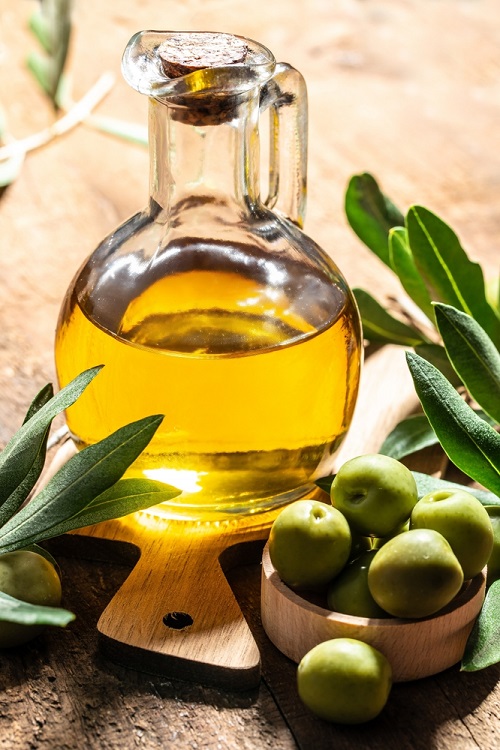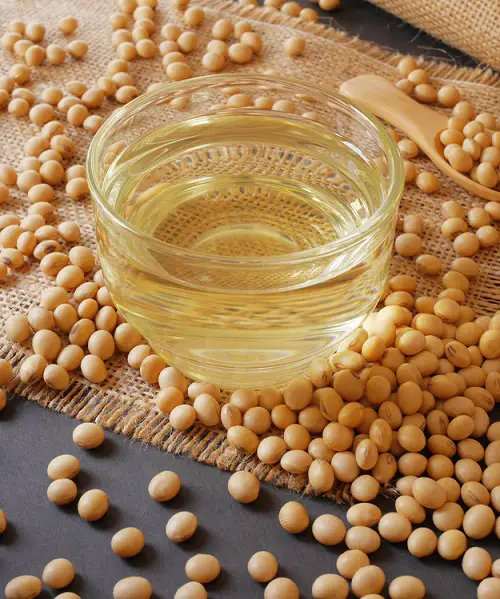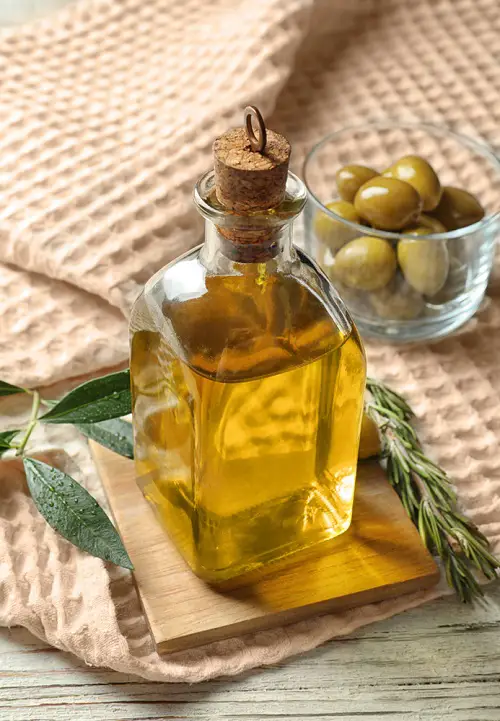Is olive oil a seed oil or not? What differentiates the two and which one should you pick? Learn below!
Celebrated for its Mediterranean charm and cherished as a culinary gem pressed and savored for centuries, olive oil poses a puzzling question—Is Olive Oil a Seed Oil? Let’s explore the answers below!
What Is Olive Oil?

Extracted from the fruit of the Olea europaea tree, olive oil is a liquid fat commonly used in cooking. It’s obtained by pressing whole olives and has a rich history dating back to ancient Mediterranean civilizations.
Spain leads global production, followed by Italy, Greece, Tunisia, Turkey, and Morocco. The composition of olive oil varies, but it’s mostly made up of oleic acid (up to 83%), along with smaller amounts of linoleic acid and palmitic acid. And when it comes to extra virgin olive oil, prized for its exceptional flavor, it must have no more than 0.8% free acidity.
To your surprise, olive oil’s benefits extend beyond culinary to cosmetics, pharmaceuticals, and traditional oil lamps!
What Are Seed Oils?
As the name suggests, seed oils are vegetable oils extracted from the seeds of various plants, such as sunflower, soybean, canola, and flaxseed. These oils are rich in polyunsaturated and monounsaturated fats, which are considered heart-healthy fats. They often contain omega-3 and omega-6 fatty acids that support various bodily functions, including brain health and inflammation regulation.
Seed oils are commonly used in cooking and food production. However, they can vary in nutritional value and stability, with some being more prone to oxidation when heated, making them unfit for culinary purposes. So, it is important to choose cold-pressed or minimally processed seed oils to retain their nutritional benefits.
Is Olive Oil A Seed Oil?
No, olive oil is not a seed oil.
While it has often been mistakenly labeled as such, the truth lies in its origin. Olive oil is made from the flesh of olives, which involves the entire fruit, the flesh, and the pit—not just their seeds.
This sets it apart from seed oils like sunflower or canola oil, which are derived specifically from plant seeds. This difference also influences the flavor, nutritional benefits, and overall composition of olive oil, making it unique compared to seed oils.
Which Oil Is Healthier?

Olive oil and seed oil each have their unique qualities. Understanding the difference in certain parameters can guide our choices:
1. Source and Extraction
Olive Oil:
It comes from pressing the whole fruit of the olive tree, specifically the olive itself. The most valuable type, extra virgin olive oil (EVOO), is obtained through a cold-pressing process that preserves its natural flavor and nutrients without the use of chemicals or excessive heat.
Seed Oils:
Most seed oils, such as sunflower, canola, and soybean oil, are extracted from the seeds of various plants. These oils are usually produced using high-heat methods or chemical solvents, which potentially strip away some of their natural nutrients.
2. Nutritional Content
Olive Oil:
Olive oil is rich in monounsaturated fats, particularly oleic acid, which supports heart health by lowering bad cholesterol (LDL) and raising good cholesterol (HDL). It’s packed with antioxidants like vitamin E and polyphenols, which help protect your body from oxidative stress and inflammation, reducing the risk of chronic diseases.
Additionally, it has a balanced ratio of omega-3 to omega-6 fatty acids, which is beneficial for reducing inflammation and supporting overall health.
Seed Oils:
On the other hand, seed oils tend to be higher in polyunsaturated fats, including omega-6 fatty acids. While these fats are essential for your body, an excess—especially without enough omega-3s—can lead to increased inflammation.
The refining process for most seed oils can reduce their antioxidant content, making them less beneficial in protecting against oxidative damage.
Many seed oils have a higher omega-6 to omega-3 ratio, which, if consumed in large amounts, can disrupt the balance and promote inflammation in the body.
3. Health Benefits
Olive Oil:
Studies show that regular consumption of olive oil, particularly EVOO, promotes heart health. It helps lower LDL cholesterol, reduce blood pressure, and decrease the risk of heart disease. Olive oil’s antioxidants and monounsaturated fats work together to reduce inflammation, which is at the root of many chronic conditions, including arthritis and diabetes.
Seed Oils:
While some seed oils, like canola oil, are often promoted for heart health due to their low saturated fat content, their high omega-6 levels can counteract these benefits if not balanced with enough omega-3 intake.
Similarly, consuming large amounts of omega-6-rich seed oils without adequate omega-3s can lead to an imbalance, increasing the risk of inflammation-related health issues.
4. Culinary Uses
Olive Oil:
Olive oil is extremely versatile and can be used for everything from salad dressings to sautéing and roasting. Its rich flavor enhances the taste of many dishes. Extra virgin olive oil is stable at moderate cooking temperatures, making it suitable for most cooking methods.
Seed Oils:
Seed oils typically have a neutral flavor, making them a good option for baking, frying, or cooking dishes where you don’t want the oil to alter the taste. Many seed oils, such as sunflower and canola oil, have high smoke points, which makes them ideal for high-heat cooking methods like deep frying.
Things To Consider While Selecting the Right Oil

When choosing between olive oil and seed oil, consider the following precautions:
1. Smoke Point
Olive oil has a lower smoke point compared to most seed oils, meaning it can break down at high temperatures. If you’re cooking at high heat, like frying, consider using seed oils with higher smoke points to avoid the oil reaching its smoke point and potentially forming harmful compounds.
2. Nutritional Profile
Olive oil is rich in monounsaturated fats, while seed oils like canola and sunflower oil contain a mix of monounsaturated and polyunsaturated fats. Consider your dietary needs and the health benefits associated with each type of fat when choosing between the oils.
3. Flavor Preference
Olive oil has a distinct flavor that may not be suitable for all dishes. Seed oils have a more neutral flavor, making them versatile for various cooking applications. Consider the flavor profile of the oil and how it complements your dish.
4. Cooking Application
Consider the cooking method you’ll be using. Olive oil’s unique flavor makes it ideal for drizzling over salads or dipping bread, while seed oils with neutral flavors are better suited for frying or baking.
5. Quality And Purity
Look for certifications such as “extra virgin” for olive oil, which signifies the highest quality and minimal processing. For seed oils, opt for cold-pressed or expeller-pressed varieties to ensure they retain their natural flavors and nutrients without the use of chemicals.
Conclusion
When comparing olive oil to seed oils, olive oil—particularly extra virgin olive oil—comes out on top as the healthier choice. It’s rich in monounsaturated fats, loaded with antioxidants, and has a balanced ratio of omega-3 to omega-6 fatty acids, making it especially beneficial for heart health and reducing inflammation.
While seed oils can be useful in certain cooking methods, their potential to promote inflammation due to high omega-6 content means they should be consumed in moderation. If you’re looking for an oil to use regularly in your kitchen, olive oil is generally the better option for both your health and culinary needs.

